Natural Food Colorants Market Size
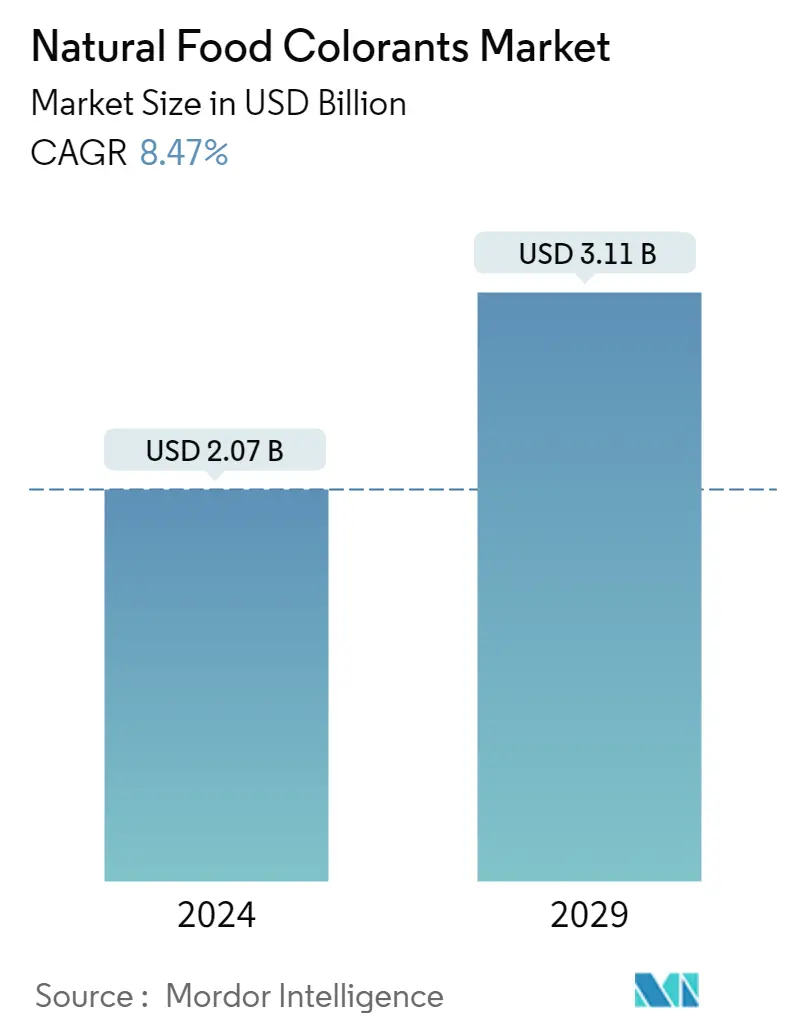
| Study Period | 2019 - 2029 |
| Market Size (2024) | USD 2.07 Billion |
| Market Size (2029) | USD 3.11 Billion |
| CAGR (2024 - 2029) | 8.47 % |
| Fastest Growing Market | Asia Pacific |
| Largest Market | North America |
Major Players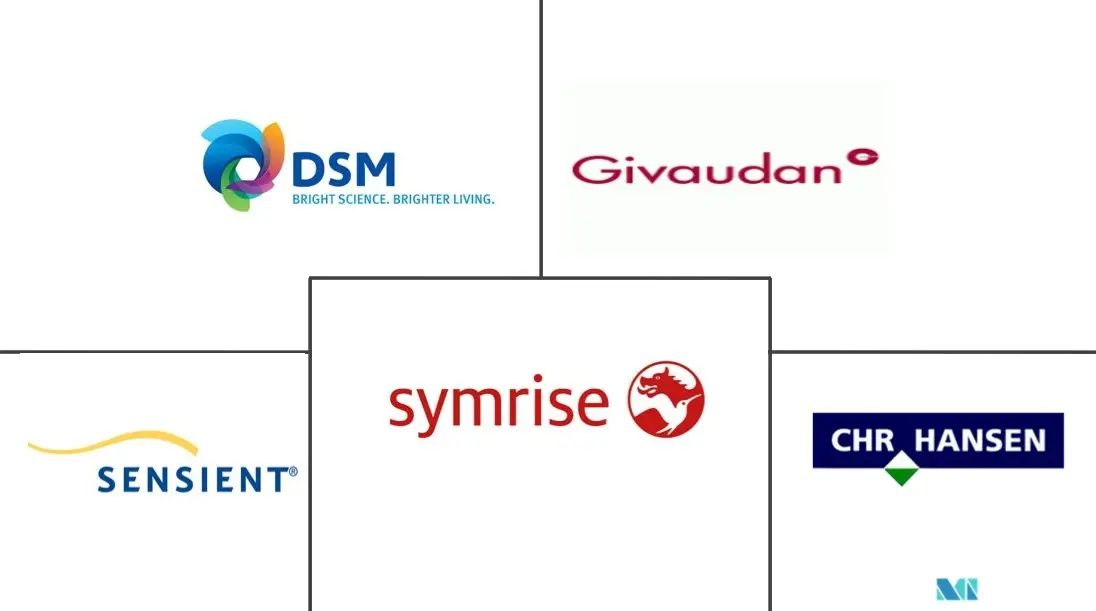
*Disclaimer: Major Players sorted in no particular order |
Natural Food Colorants Market Analysis
The Natural Food Colorants Market size is estimated at USD 2.07 billion in 2024, and is expected to reach USD 3.11 billion by 2029, growing at a CAGR of 8.47% during the forecast period (2024-2029).
The COVID-19 pandemic has increased consumers' desire to know where their food comes from, while food affordability continues as a greater concern among consumers worldwide. Moreover, the demand for locally produced food has escalated because the consumers are afraid of being infected by consuming more imported products that have a mysterious and unspecified ingredient origin. This has, in turn, benefited the new private label entrants in the food industry, as well as the local manufacturers of natural colorants.
As the situation generates continuous demands to suppress and ultimately stifle the spread of the global COVID-19 pandemic, the world's scientific and medical communities recommend the use of nutraceuticals to improve health and immunity, which is advantageous for the natural food colorant industry.
The high functionality of superfood, along with the positive perception of the term 'natural,' has been the primary attribute raising the natural food colorant demand in the market. Consumers are greatly fascinated to use products with simple and understandable labels, which is pushing food companies to instead opt for coloring foodstuffs than other alternatives present in the industry.
However, the high cost of extraction and expensive raw materials discourage food manufacturers, primarily in developing countries, from being as progressive as big firms and brands that are constantly rooting for healthier food products. This factor is strongly identified as a significant market constraint, restricting natural food colorant to outperform in the industry.
Natural Food Colorants Market Trends
This section covers the major market trends shaping the Natural Food Colorants Market according to our research experts:
Brightening Spotlight on Coloring Foodstuff
Food colors, in the form of coloring foodstuffs, have proven as no less than a revolution for the food industry that is currently being driven by value-added products and ethical consumerism. Consumers redirect their interest toward food products that are not only health-oriented but are ethically sourced, leaving none or least impact on the environment. Moreover, this thrusts the demand for natural food colorants and stresses R&D activities to introduce unprecedented technologies in order to exploit the maximum commercial potential of the market. For instance, in 2019, Naturex introduced Vegebrite® Ultimate Spirulina, a spirulina-based coloring foodstuff that uses a water-based extraction process to ensure a 100% natural solution by delivering clean-label and trehalose-free formulations. It is available in various concentrations and formats.
This changing consumer behavior and market dynamics for food colorants are pushing food manufacturers to quit formulating artificial additives in food products. As a result, major food companies, such as Kellogg's, General Mills, Nestle SA, Campbell, and Kraft, have assured to restrict the use of artificial additives and colorants from their product formulations, portraying promising future for natural colorants, during the forecast period.
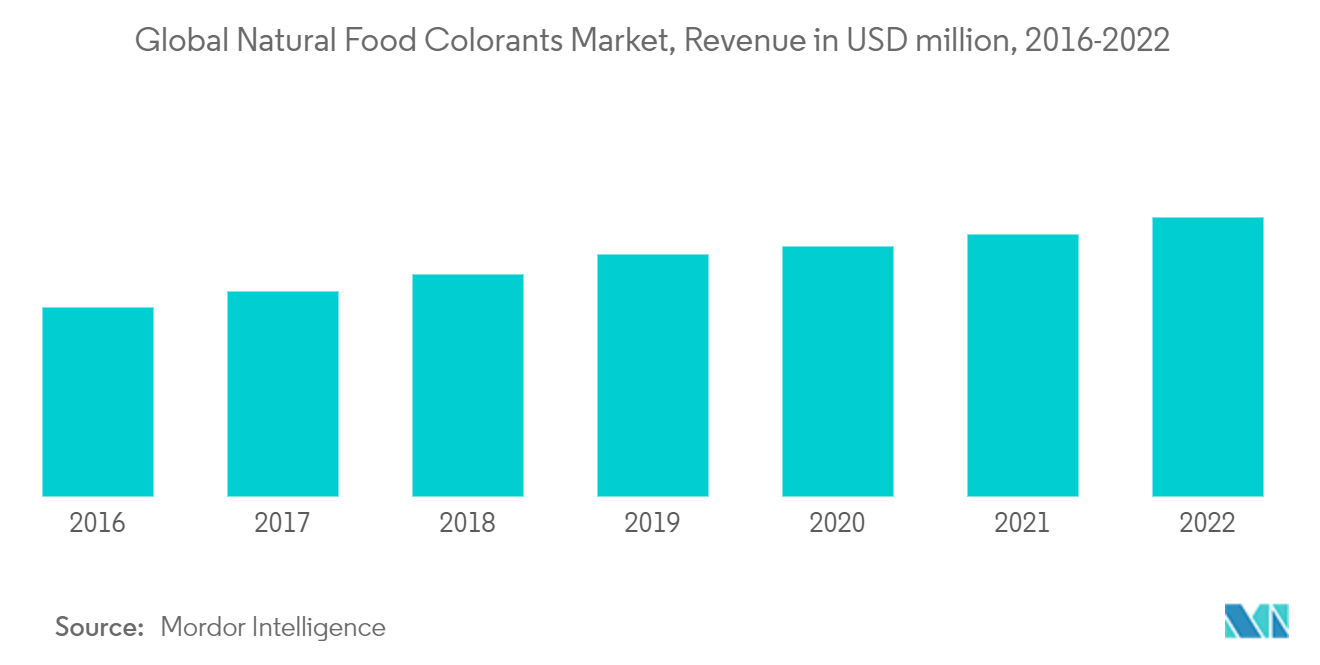
Asia-Pacific is the Fastest-growing Region in the Market
The leading natural food colorant manufacturers across the region possess a variety of application technologies, which they can utilize to test the performances of colors in a wide range of food and beverage applications. These include but are not limited to soft drinks, alcoholic drinks, confectionery, frozen desserts, yogurts, baked goods, and processed foods. Natural food colors are used in the Asian food and beverage industry for various reasons. They make food products more visually appealing and emphasize or identify flavors normally associated with various applications. Owing to the wide cultivation of herbs and spices in the region, Asian ingredient companies started developing food coloring additives from various spices like turmeric, red chilies, and hibiscus. They offer multiple tints of yellow, red, pink, and orange colors from the combinations of paprika, curcumin, and hibiscus. These colorants are popular in desserts and beverage applications.
Notably, China represents the largest market in Asia-Pacific as the country accounted for more than 50% share across the APAC market in 2020. The Chinese food colorants market is driven by the advanced usage of naturally derived food colorants making the food appear attractive. A few of the popular natural food colorants used in Chinese food cuisines are carmine, bixin and norbixin, carotenoids, curcumin, anthocyanin, betanin, and phycobilin.
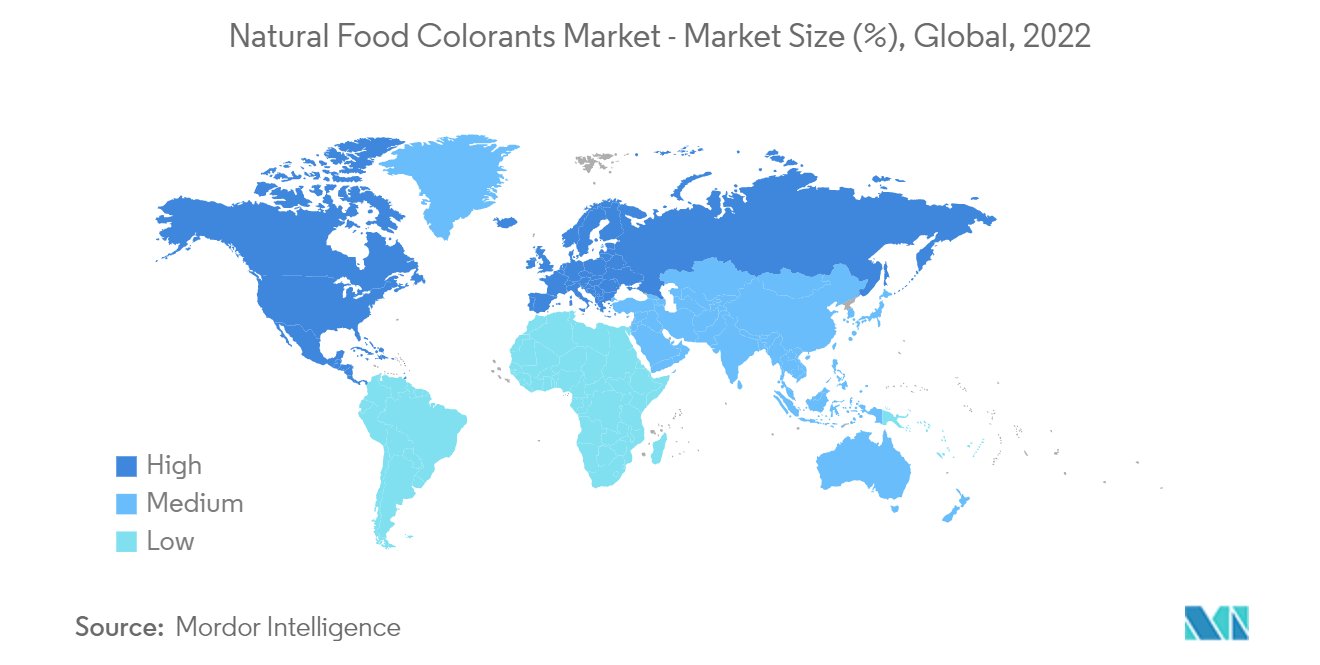
Natural Food Colorants Industry Overview
The market studied is consolidated with few companies that emerged as the leading players owing to their market share in 2020, including Chr. Hansen Holding AS, Givaudan (Naturex), Koninklijke DSM NV, Sensient Technologies, and Symrise AG. The key players in the market studied are increasingly relying on product innovation and business expansion as the most adopted strategies among all others. There has been an extensive investment in R&D in the past years, which led to the introduction of numerous new products in the market. Moreover, merger and acquisition was another important strategy among manufacturers like DDW, The Color House, and Sensient Technologies.
Natural Food Colorants Market Leaders
-
Chr. Hansen Holding A/S
-
Givaudan (Naturex)
-
Koninklijke DSM NV
-
Sensient Technologies
-
Symrise AG
*Disclaimer: Major Players sorted in no particular order
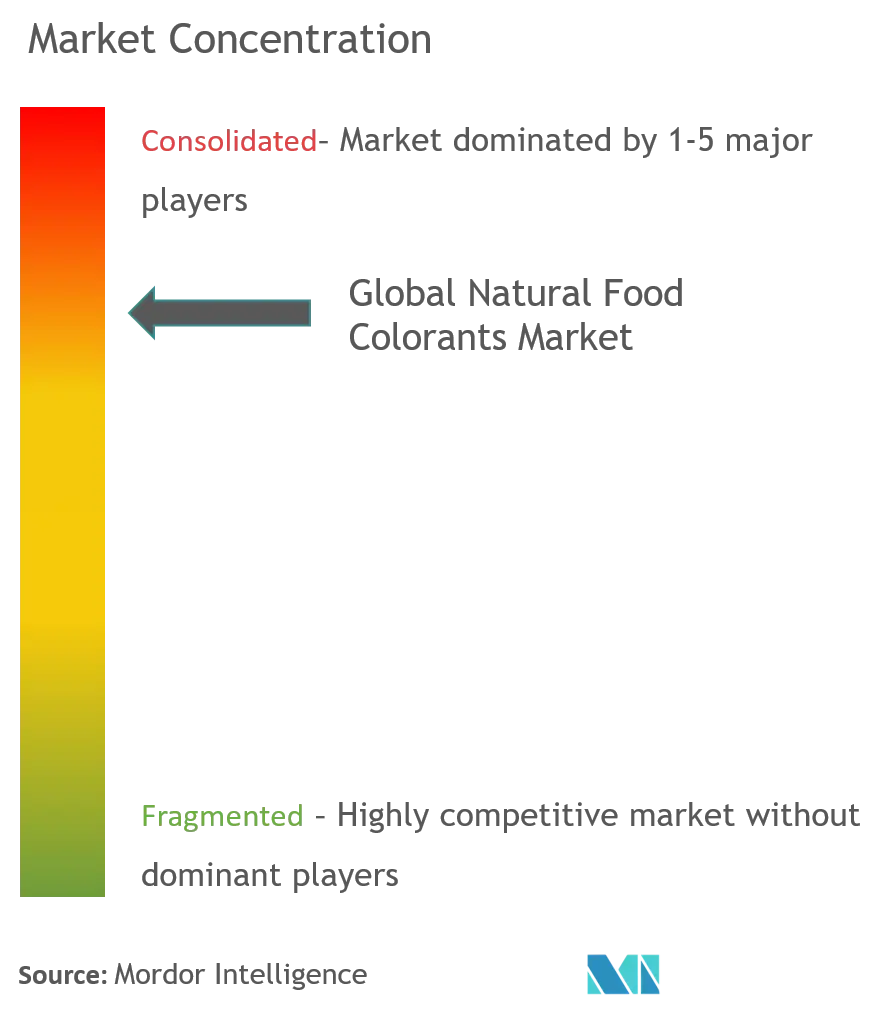
Natural Food Colorants Market News
- In January 2021, GNT Group added a new pink shade coloring agent under its EXBERRY® brand with the name EXBERRY® Shade Pink - OD, which is developed for use in fat-based applications. It is also available in red, yellow, orange, blue, and green variants.
- In October 2020, Chr. Hansen Natural Colors established an R&D center to augment the pigment, formulation, and application capabilities in Montpellier, France, with an aim to introduce new natural color solutions, particularly for green, blue and brown hues.
- In September 2018, Givaudan SA completed the acquisition of Naturex, one of the leading natural ingredient companies, to supplement its capabilities with its strong portfolio of plant extracts and natural ingredients across the food and beverage, nutrition and health, and personal care sectors.
- In April 2016, Sensient® Colors, a division of Sensient Technologies, launched a new SupraRed™, a heat-stable natural red color used for neutral Ph baking and dry grocery products.
Natural Food Colorants Market Report - Table of Contents
1. INTRODUCTION
- 1.1 Study Assumptions and Market Definition
- 1.2 Scope of the Study
2. RESEARCH METHODOLOGY
3. EXECUTIVE SUMMARY
4. MARKET DYNAMICS
- 4.1 Market Drivers
- 4.2 Market Restraints
-
4.3 Porter's Five Forces Analysis
- 4.3.1 Threat of New Entrants
- 4.3.2 Bargaining Power of Buyers/Consumers
- 4.3.3 Bargaining Power of Suppliers
- 4.3.4 Threat of Substitute Products
- 4.3.5 Intensity of Competitive Rivalry
5. MARKET SEGMENTATION
-
5.1 By Application
- 5.1.1 Bakery
- 5.1.2 Dairy-based Products
- 5.1.2.1 Ice Cream
- 5.1.2.2 Other Products
- 5.1.3 Beverages
- 5.1.3.1 Alcoholic Beverages
- 5.1.3.2 Non-alcoholic Beverages
- 5.1.4 Confectionery
- 5.1.5 Nutraceuticals
- 5.1.6 Snacks and Cereals
- 5.1.7 Other Applications
-
5.2 Geography
- 5.2.1 North America
- 5.2.1.1 United States
- 5.2.1.2 Canada
- 5.2.1.3 Mexico
- 5.2.1.4 Rest of North America
- 5.2.2 Europe
- 5.2.2.1 United Kingdom
- 5.2.2.2 Germany
- 5.2.2.3 Italy
- 5.2.2.4 Russia
- 5.2.2.5 Spain
- 5.2.2.6 France
- 5.2.2.7 Rest of Europe
- 5.2.3 Asia-Pacific
- 5.2.3.1 China
- 5.2.3.2 Japan
- 5.2.3.3 India
- 5.2.3.4 Australia
- 5.2.3.5 Rest of Asia-Pacific
- 5.2.4 South America
- 5.2.4.1 Brazil
- 5.2.4.2 Argentina
- 5.2.4.3 Rest of South America
- 5.2.5 Middle-East & Africa
- 5.2.5.1 United Arab Emirates
- 5.2.5.2 Saudi Arabia
- 5.2.5.3 Egypt
- 5.2.5.4 South Africa
- 5.2.5.5 Rest of Middle-East & Africa
6. COMPETITIVE LANDSCAPE
- 6.1 Market Share Analysis
- 6.2 Strategies Adopted by Leading Players
-
6.3 Company Profiles
- 6.3.1 Chr. Hansen Holding AS
- 6.3.2 Synthite Industries Private Ltd
- 6.3.3 Kalsec Inc.
- 6.3.4 Givaudan SA
- 6.3.5 Symrise AG
- 6.3.6 DDW Inc.
- 6.3.7 Koninklijke DSM NV
- 6.3.8 Sensient Technologies
- 6.3.9 Archer Daniels Midland Company
- *List Not Exhaustive
7. MARKET OPPORTUNITIES AND FUTURE TRENDS
** Subject To AvailablityNatural Food Colorants Industry Segmentation
Natural food colors are preparations obtained from foods and other edible natural source materials obtained by physical and/or chemical extraction resulting in selective extraction of the pigments relative to the nutritive or aromatic constituents. The Global Natural Food Colorants Market is segmented by application (bakery, dairy-based products, beverages, confectionery, nutraceuticals, snacks and cereals, and other applications) and Geography into North America, Europe, Asia-Pacific, South America, and Middle-East and Africa. The report offers the market size in USD million for all the above segments.
| By Application | Bakery | |
| Dairy-based Products | Ice Cream | |
| Other Products | ||
| Beverages | Alcoholic Beverages | |
| Non-alcoholic Beverages | ||
| Confectionery | ||
| Nutraceuticals | ||
| Snacks and Cereals | ||
| Other Applications | ||
| Geography | North America | United States |
| Canada | ||
| Mexico | ||
| Rest of North America | ||
| Geography | Europe | United Kingdom |
| Germany | ||
| Italy | ||
| Russia | ||
| Spain | ||
| France | ||
| Rest of Europe | ||
| Geography | Asia-Pacific | China |
| Japan | ||
| India | ||
| Australia | ||
| Rest of Asia-Pacific | ||
| Geography | South America | Brazil |
| Argentina | ||
| Rest of South America | ||
| Geography | Middle-East & Africa | United Arab Emirates |
| Saudi Arabia | ||
| Egypt | ||
| South Africa | ||
| Rest of Middle-East & Africa |
Natural Food Colorants Market Research FAQs
How big is the Natural Food Colorants Market?
The Natural Food Colorants Market size is expected to reach USD 2.07 billion in 2024 and grow at a CAGR of 8.47% to reach USD 3.11 billion by 2029.
What is the current Natural Food Colorants Market size?
In 2024, the Natural Food Colorants Market size is expected to reach USD 2.07 billion.
Who are the key players in Natural Food Colorants Market?
Chr. Hansen Holding A/S, Givaudan (Naturex), Koninklijke DSM NV, Sensient Technologies and Symrise AG are the major companies operating in the Natural Food Colorants Market.
Which is the fastest growing region in Natural Food Colorants Market?
Asia Pacific is estimated to grow at the highest CAGR over the forecast period (2024-2029).
Which region has the biggest share in Natural Food Colorants Market?
In 2024, the North America accounts for the largest market share in Natural Food Colorants Market.
What years does this Natural Food Colorants Market cover, and what was the market size in 2023?
In 2023, the Natural Food Colorants Market size was estimated at USD 1.91 billion. The report covers the Natural Food Colorants Market historical market size for years: 2019, 2020, 2021, 2022 and 2023. The report also forecasts the Natural Food Colorants Market size for years: 2024, 2025, 2026, 2027, 2028 and 2029.
Natural Food Colorants Industry Report
The Natural Food Colorants Market is segmented by application into various categories such as bakery, dairy-based products, beverages, confectionery, nutraceuticals, snacks and cereals, and other applications. The market is also segmented by geography, covering North America, Europe, Asia-Pacific, South America, and the Middle-East and Africa. The market analysis includes a historical overview and a forecast outlook, providing insights into market trends and market growth.
The market size for natural food colorants is measured in value, offering a detailed industry overview. This industry report, created by Mordor Intelligence™ Industry Reports, includes a comprehensive market forecast that extends to the future. The report provides valuable industry information, including market share and market segmentation, which are crucial for understanding the dynamics of the global market.
Industry reports highlight the importance of natural food colorants in various applications, emphasizing their significance in the food and beverage industry. The market research delves into the factors driving market growth and the key market leaders who are shaping the industry. The report also includes industry statistics and market data, which are essential for making informed business decisions.
The market outlook and market review sections provide a detailed analysis of the current state of the market, along with predictions for future growth. Industry analysis and industry research are integral parts of the report, offering insights into the competitive landscape and market value. The report pdf is available as a free download, providing an example of the comprehensive research conducted by the report companies.
In summary, the natural food colorants market is poised for significant growth, driven by increasing demand across various applications and regions. The industry trends and market forecast indicate a positive trajectory, supported by detailed market segmentation and industry sales data. This report serves as a valuable resource for understanding the market dynamics and making strategic decisions in the natural food colorants industry.



